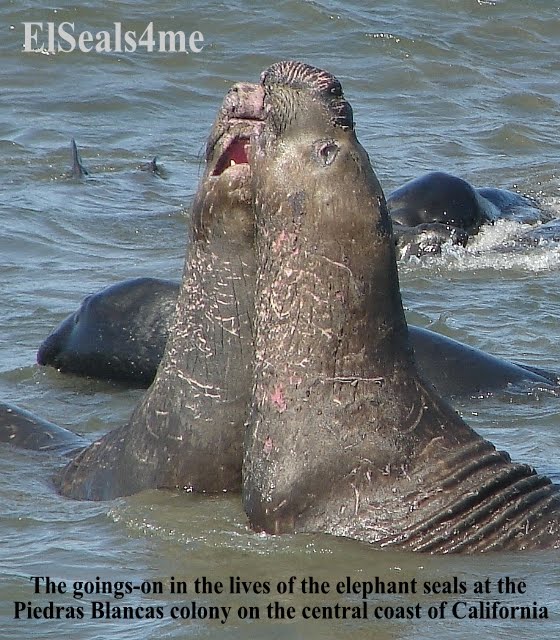
Despite the extraordinarily aggressive behavior of many of the moms this birthing season, most of the pups have flourished and many are now entering the stage of weanerdom. ( The pups are renamed weaners when the mom turns off the milk spigot after about 4 weeks of nursing and heads out to sea to feed and replenish her lost weight, leaving her offspring on shore to fend for itself. )
The biggest danger to the pups this birthing season has not been severe storms or amorous males looking to mate but the unusally pugnacious actions of many of the moms. These females have been quick to dash across several yards of beach to bite or even pick up and toss pups through the air with extreme regularity as can be evidenced by the large number of cuts and bite marks on nearly all the pups/weaners.


Maybe because the alpha males have successfully kept at bay what few love-struck males have tried to gallop across the beaches to mate with unwilling females, the nursing pups and their moms have largely remained uninterrupted over the bulk of the birthing season.
( It's not that the males intend harm to the pups, but their intrusions create unrest and force the moms and pups to keep moving around, cutting into nursing times and causing them to use up precious calories.)
Click here to see video of pups/weaners trying to wiggle their way out from under a huge bull.
In the photos, you can see how truly huge some of these weaners have become. Some of them have even almost attained the length of their moms in just a few short weeks of gorging themselves !
( Since so many of the weaners are big, round and comical this year, I feel tempted to nickname them butterballs.)
Click here for weaner and pup photos.
Nevertheless, in the last few days, more males have been starting to show up, and now the previously half-hearted mating attempts are getting more serious. At least these males are starting to achieve their goals with the now more complacent younger adult females before gettting run off the beaches by this year's more-than-usual protective alpha males or other large males intent on getting their share of the mating. ( Scientists claim that the females enter into estrus about 3 weeks after giving birth. )
Click here for photos of males in action.
Click here for video of various mating attempts.









